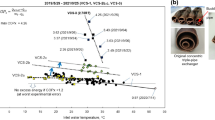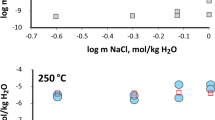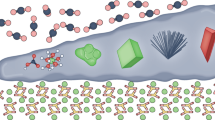Abstract
Water is known to exhibit fascinating physical properties at high pressure and temperature. Its remarkable structural and phase complexities suggest the possibility of exotic chemical reactivity under extreme conditions, although this remains largely unstudied. Detonations of high explosives containing oxygen and hydrogen produce water at thousands of kelvin and tens of gigapascals, similar to conditions in the interiors of giant planets. These systems thus provide a unique means of elucidating the chemistry of ‘extreme water’. Here, we show that water has an unexpected role in catalysing complex explosive reactions—contrary to the current view that it is simply a stable detonation product. Using first-principles atomistic simulations of the detonation of the high explosive pentaerythritol tetranitrate, we discovered that H2O (source), H (reducer) and OH (oxidizer) act as a dynamic team that transports oxygen between reaction centres. Our finding suggests that water may catalyse reactions in other explosives and in planetary interiors.
This is a preview of subscription content, access via your institution
Access options
Subscribe to this journal
Receive 12 print issues and online access
$259.00 per year
only $21.58 per issue
Buy this article
- Purchase on Springer Link
- Instant access to full article PDF
Prices may be subject to local taxes which are calculated during checkout





Similar content being viewed by others
References
Hubbard, W. B. Neptune's deep chemistry. Science 275, 1279–1280 (1997).
Cavazzoni, C. et al. Superionic and metallic states of water and ammonia at giant planet conditions. Science 283, 44–46 (1999).
Hemley, R. J. et al. Static compression of H2O-ice to 128 GPa (1.28 Mbar). Nature 330, 737–740 (1987).
Goncharov, A. F., Struzhkin, V. V., Somayazulu, M. S., Hemley, R. J. & Mao, H. K. Compression of ice to 210 gigapascals: Infrared evidence for a symmetric hydrogen-bonded phase. Science 273, 218–220 (1996).
Goncharov, A.F. et al. Dynamic ionization of water under extreme conditions. Phys. Rev. Lett. 94, 125508 (2005).
Goldman, N., Fried, L. E., Kuo, I. F. W. & Mundy, C. J. Bonding in the superionic phase of water. Phys. Rev. Lett. 94, 217801 (2005).
Lin, J. F. et al. Melting behavior of H2O at high pressures and temperatures. Geophys. Res. Lett. 32, L11306 (2005).
Holmes, N. C., Nellis, W. J., Graham, W. B. & Walrafen, G. E. Spontaneous Raman scattering from shocked water. Phys. Rev. Lett. 55, 2433–2436 (1985).
Schwegler, E., Galli, G., Gygi, F. & Hood, R. Q. Dissociation of water under pressure. Phys. Rev. Lett. 87, 265501 (2001).
Ding, Z. Y., Frisch, M. A., Li, L. & Gloyna, E. F. Catalytic oxidation in supercritical water. Ind. Eng. Chem. Res. 35, 3257–3279 (1996).
Farinacci, N. T. & Hammett, L. P. Polymolecular solvolytic reactions: Water catalysis in the alcoholysis of benzhydryl chloride. J. Am. Chem. Soc. 59, 2542–2546 (1937).
Vohringer-Martinez, E. et al. Water catalysis of a radical-molecule gas-phase reaction. Science 315, 497–501 (2007).
Smith, I. Single-molecule catalysis. Science 315, 470–471 (2007).
Ree, F. H. A statistical mechanical theory of chemically reacting multiphase mixtures: Application to the detonation properties of PETN. J. Chem. Phys. 81, 1251–1263 (1984).
Fried, L. E. & Howard, W. M. An accurate equation of state for the exponential-6 fluid applied to dense nitrogen. J. Chem. Phys. 109, 7338–7348 (1998).
Ng, W. L., Field, J. E. & Hauser, H. M. Thermal, fracture, and laser-induced decomposition of pentaerythritol tetranitrate. J. Appl. Phys. 59, 3945–3952 (1986).
Gruzdkov, Y. A. & Gupta, Y. M. Shock wave initiation of pentaerythritol tetranitrate crystals: Mechanism of anisotropic sensitivity. J. Phys. Chem. A 104, 11169–11176 (2000).
Yoo, C. S. et al. Anisotropic shock sensitivity and detonation temperature of pentaerythritol tetranitrate single crystal. J. Appl. Phys. 88, 70–75 (2000).
Tarver, C. M., Tran, T. D. & Whipple, R. E. Thermal decomposition of pentaerythritol tetranitrate. Propell. Explos. Pyrot. 28 189–193 (2003).
Wu, C. J., Manaa, M. R. & Fried, L. E. Tight binding molecular dynamic simulation of PETN decomposition at an extreme condition. Proc. Mater. Res. Soc., 987, 139–144 (2007).
Manaa, M. R., Fried, L. E., Melius, C. F., Elstner, M. & Frauenheim, T. Decomposition of HMX at extreme conditions: A molecular dynamics simulation, J. Phys. Chem. A 106, 9024–9029 (2002).
Strachan, A., van Duin, A. C. T., Chakraborty, D., Dasgupta, S. & Goddard, W. A. III Shock waves in high-energy materials: The initial chemical events in nitramine RDX. Phys. Rev. Lett. 91, 098301 (2003).
Strachan, A., Kober, E. M., van Duin, A. C. T., Oxgaard, J. & Goddard, W. A. III Thermal decomposition of RDX from reactive molecular dynamics. J. Chem. Phys. 122, 054502 (2005).
Nomura, K. et al. Dynamic transition in the structure of an energetic crystal during chemical reactions at shock front prior to detonation. Phys. Rev. Lett. 99, 148303 (2007).
Reed, E. J., Manna, M. R., Fried, L. E., Glaesemann, K. R. & Joannopoulos, J. D. A transient semimetallic layer in detonating nitromethane. Nature Phys. 4, 72–76 (2008).
Westbrook, C. K. & Dryer, F. L. Chemical kinetic modeling of hydrocarbon combustion. Prog. Energy Combust. 10, 1–57 (1984).
Westbrook, C. K. Chemical kinetics of hydrocarbon ignition in practical combusion systems. Proc. Combust. Inst. 28, 1563–1577 (2000).
Giguere, P. A. Great fallacy of the H+ ion and the true nature of H3O+. J. Chem. Educ. 56, 571–575 (1979).
Pauling, L. The Nature of the Chemical Bond 90 (Cornell Univ. Press, 1960).
Bastea, S. & Fried, L. E. Exp6-polar thermodynamics of dense supercritical water. J. Chem. Phys. 128, 174502 (2008).
Hansen, J. P. & McDonald, I. R. Statistical mechanics of dense ionized matter. IV. Density and charge fluctuations in a simple molten salt. Phys. Rev. A 11, 2111–2123 (1975).
Wilke, S. D., Chen, H. C. & Bosse, J. Dielectric and transport properties of a supercooled symmetrical molten salt. Phys. Rev. E. 60, 3136–3149 (1999).
Clipper Controls. Dielectric Constant Reference Guide <http://clippercontrols.com/info/dielectric_constants.html> (2007).
Hayes, B. On electrical conductivity in detonation products. Proc. 4th Int. Symp. Detonation, White Oak, Massachusetts 595–601 (Office of Naval Research, Department of the Navy, October 1965).
Weinert, U. & Mason, E. A. Generalized Nernst–Einstein relations for nonlinear transport coefficients. Phys. Rev. A 21, 681–690 (1980).
Booth, A. D. & Llewellyn, F. J. The crystal structure of pentaerythritol tetranitrate. J. Chem. Soc. 837–846 (1947).
Trotter, J. Bond lengths and angles in pentaerythritol tetranitrate. Acta Crystallogr. 16, 698–699 (1963).
Yang, L. H., Hood, R. Q., Pask, J. E. & Klepeis, J. E. Large-scale quantum mechanical simulations of high-Z metals. J. Computer-Aided Mater. Design 14, 337–347 (2007).
Perdew, J. P., Burke, K. & Ernzerhof, M. Generalized gradient approximation made simple. Phys. Rev. Lett. 77, 3865–3868 (1996).
Troullier, N. & Martins, J. L. Efficient pesudopotentials for plane-wave calculations. Phys. Rev. B 43, 1993–2006 (1991).
Brown, D. & Clarke, J. H. R. A comparison of constant energy, constant temperature and constant pressure ensembles in molecular-dynamics simulations of atomic liquids. Mol. Phys. 51, 1243–1254 (1999).
Frauenheim, T. et al. A self-consistent charge density-functional based tight-binding method for predictive materials simulations in physics, chemistry and biology. Phys. Status Solidi B 217, 41–62 (2000).
Mulliken, R. S. Electron population analysis on LCAO-MO molecular wave functions. J. Chem. Phys. 23, 1833–1840 (1955).
CP2K Developers Group. CP2K Code <http://cpk2.berlios.de> (2000–2006).
Van de Vondele, J. et al. Quickstep: Fast and accurate density functional calculations using a mixed Gaussian and plane waves approach. Comput. Phys. Commun. 167, 103 (2005).
Acknowledgements
This work was performed under the auspices of the US Department of Energy by Lawrence Livermore National Laboratory (LLNL) under Contract DE-AC52-07NA27344. The project 06-SI-005 was funded by the Laboratory Directed Research and Development Program at LLNL. The authors would like to express their sincere appreciation to E. Reed for useful discussion and to L. Krauss, K. Kline and J. McInnis for their contributions to the preparation of the manuscript and figures.
Author information
Authors and Affiliations
Contributions
C.J.W. originated the central idea, performed and analysed the PETN MD simulations, and wrote the paper; L.E.F. developed the molecular analyser code and contributed to the writing of the paper; L.H.Y. carried out Quantum MD code development; N.G. contributed to Mulliken charge analysis; S.B. performed conductivity and dielectric constant calculations; all of the authors contributed to discussions and editing of the manuscript.
Corresponding author
Supplementary information
Supplementary Information
Supplementary Information (PDF 775 kb)
Rights and permissions
About this article
Cite this article
Wu, C., Fried, L., Yang, L. et al. Catalytic behaviour of dense hot water. Nature Chem 1, 57–62 (2009). https://doi.org/10.1038/nchem.130
Received:
Accepted:
Published:
Issue Date:
DOI: https://doi.org/10.1038/nchem.130
This article is cited by
-
Thermal decomposition mechanisms of energetic CL-20-based co-crystals: quantum molecular dynamics simulations
Journal of Molecular Modeling (2022)
-
Effect of FeO on Spinel Crystallization and Chromium Stability in Stainless Steel-Making Slag
JOM (2019)
-
Detonation synthesis of carbon nano-onions via liquid carbon condensation
Nature Communications (2019)
-
Nanocarbon condensation in detonation
Scientific Reports (2017)
-
Nanocarbon synthesis by high-temperature oxidation of nanoparticles
Scientific Reports (2016)



